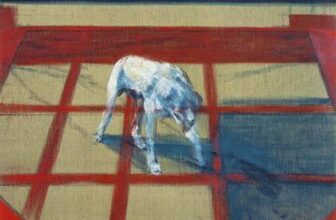
A Masterpiece of Devotion, Patriotism, and Romantic Idealism
In the rich annals of Western art, few paintings encapsulate the drama of history, the mystique of faith, and the surge of national pride as powerfully as Joan of Arc at the Coronation of Charles VII by Jean Auguste Dominique Ingres. Painted in 1854, this evocative masterpiece is not only a tribute to a legendary French heroine but also a brilliant example of Romantic historicism and classical composition, rendered with the academic precision that Ingres was so famous for.
Let us journey into the world behind the canvas, into the historical, artistic, and emotional layers that make this painting one of the most iconic representations of Joan of Arc in Western art.
Who Was Joan of Arc? The Woman Behind the Legend
Before examining the painting itself, it is essential to understand the story of Joan of Arc, France’s “Maid of Orléans,” a mystic, warrior, and martyr. Born in 1412 in Domrémy, a village in northeastern France, Joan grew up during the latter years of the Hundred Years’ War, a protracted conflict between England and France over the French throne.
At the age of 13, Joan began to experience visions and hear voices she attributed to saints, St. Michael, St. Catherine, and St. Margaret, commanding her to support Charles VII and help drive the English out of France. Against all odds, she convinced the Dauphin (heir to the throne) to let her lead a military force to relieve the besieged city of Orléans. Her leadership galvanized French troops, and her victories culminated in the coronation of Charles VII in the cathedral of Reims on July 17, 1429.
Tragically, Joan was captured by Burgundian allies of the English less than a year later, tried for heresy, and burned at the stake in 1431 at the age of 19. She was canonized as a saint by the Catholic Church in 1920.
The Historical Event: Coronation of Charles VII at Reims
The moment Ingres chose to depict, Charles VII’s coronation, is a turning point in French history and a profound emotional climax in Joan’s personal narrative. After years of instability and occupation, the crowning of the rightful king at Reims, a traditional place for royal anointing, marked a restoration of French national unity and legitimacy. It was Joan’s faith and bravery that helped make this event possible.
Ingres’ painting captures not the ceremony itself in its political gravity, but the sacred and personal essence of the event, through Joan’s presence. This was the moment when her divine mission was fulfilled.
What the Painting Is All About: A Glimpse of Transcendence
Joan of Arc at the Coronation of Charles VII is not a documentary depiction of a historical event. Rather, it is an idealized, emotional portrayal of one of the most symbolic moments in French history. Joan is the focus, not the king. This subtle yet crucial emphasis tells us much about the message of the painting.
Joan stands in armor, sword in hand, in the grand interior of Reims Cathedral. Her head is turned upward, her eyes gazing toward the heavens, as if in communion with the divine. Behind her, Charles VII kneels at the altar, receiving the crown. The viewer, however, is drawn not to the ceremony in the background, but to Joan, her stillness, strength, and piety.
Her expression is serene and contemplative, suggesting that she is not reveling in triumph, but reflecting deeply on the divine source of her mission. Her armor glints under the light that seems to emanate more from the sacred space than any natural source, giving her a saintly aura. Her left hand rests gently on the hilt of her sword, a sign of peace after battle, and a symbol of divine justice rather than personal glory.
In essence, the painting is about divine mission, faith fulfilled, and the interplay of human history and celestial purpose. Joan is depicted not as a warrior in the heat of battle, but as a vessel of divine will, radiating a calm, spiritual strength.
What Type of Painting Is It? Style and Technique
Jean Auguste Dominique Ingres was a neoclassical painter, though his work is often associated with the Romantic movement due to its emotional depth and imaginative subject matter. Ingres trained under Jacques-Louis David, the leading neoclassical painter of revolutionary France. His technique was rooted in precision, line, and clarity, a direct inheritance from Raphael and other Renaissance masters whom he deeply admired.
Yet Ingres’ art is more than mere academic replication. His best works, like this one, imbue classical technique with romantic emotion. Joan of Arc at the Coronation of Charles VII is a synthesis of styles: the polished realism and compositional structure of neoclassicism, the drama and sentiment of romanticism, and the reverent spirituality of religious art.
The painting is oil on canvas, and measures approximately 240 x 178 cm (94.5 x 70 inches). The composition is vertical, highlighting the upward gaze of Joan and the cathedral’s towering architecture, emphasizing elevation, both physical and spiritual. Ingres employs a rich palette dominated by warm golds, cool grays, and the deep reds and blues of royal vestments and religious robes, reinforcing the painting’s regal and sacred themes.
Ingres’ meticulous brushwork and attention to texture, metallic armor, velvet, marble, and stained glass, reveal his technical mastery. Each surface glows with an inner life, enhancing the illusion of Joan’s sanctity and the reverence of the moment.
Narrative Elements: Symbols and Significance
The painting is filled with symbolic elements that deepen its narrative resonance:
Joan’s Armor: Her polished breastplate and chainmail signal her role as a warrior, but the absence of helmet and the relaxed grip on the sword denote peace, not aggression. She has laid down her arms, the mission is complete.
Sword with Cross Hilt: The sword doubles as a cruciform, reinforcing Joan’s identity as a spiritual warrior and martyr. It also symbolizes divine justice.
Upward Gaze: This pose is iconic in religious art, evoking visions, prayer, and divine revelation. It underlines Joan’s mystic connection with heaven.
Reims Cathedral Setting: Not just a historical accuracy, the cathedral signifies the legitimacy of the coronation and the sacred nature of monarchy in medieval France. Gothic arches and stained-glass windows evoke a celestial realm on earth.
Royal Entourage and Clergy: Figures in the background remind viewers that this is not just Joan’s moment, but a national restoration, France is being reborn through divine will and human courage.
The Artist’s Vision: Ingres’ Ideals and Inspirations
Ingres painted this work in the mid-19th century, during a time when France was re-evaluating its history and national identity following the upheavals of the Revolution and the Napoleonic era. Romantic nationalism, medieval revivalism, and religious renewal all fed into artistic and intellectual life. Joan of Arc, once considered a suspicious figure by the Church and monarchy, had by then become a symbol of pure patriotism and divine mission.
Ingres, a devout Catholic and monarchist, saw in Joan a perfect embodiment of his ideals. She was both a spiritual saint and a national heroine, a virgin warrior and an obedient servant of God, a contradiction and synthesis that fascinated Romantic minds.
This painting, then, is not just an artistic exercise, it is a statement. Ingres chose a moment where Joan’s soul and destiny align. Unlike depictions of her in battle or at her trial, this image emphasizes harmony, faith, and fulfillment.
Where Is the Painting Located Today?
Joan of Arc at the Coronation of Charles VII is housed in the Louvre Museum in Paris, France, where it is part of the museum’s rich collection of 19th-century French paintings. It hangs among other masterpieces of the Romantic and Neoclassical schools, offering visitors a glimpse not only into France’s artistic heritage but also into its storied past.
Visitors to the Louvre can see the painting in person, appreciating its grand scale and fine detail in a way that reproductions cannot fully convey. Standing before it, one feels the gravity of history, the presence of divine purpose, and the timeless allure of a figure who continues to inspire people across generations and nations.
Legacy of the Painting
This painting has become one of the most enduring visual representations of Joan of Arc, often reproduced in history books, religious materials, and cultural exhibitions. It has helped shape the modern image of Joan as a saintly heroine, blending piety and power.
Moreover, it reflects the enduring role of art in shaping collective memory. By capturing not only a moment in time but also the emotional and spiritual undercurrents of that moment, Ingres contributed to the legend of Joan more powerfully than any chronicle or political speech.
A Saint Crowned in Spirit
Joan of Arc at the Coronation of Charles VII is more than a painting. It is a spiritual and national allegory rendered through the lens of a master artist. Jean Auguste Dominique Ingres transformed a historical episode into a poetic meditation on faith, destiny, and the triumph of the human spirit when aligned with the divine.
Through delicate technique, dramatic composition, and deep symbolism, Ingres gives us a Joan not only of history, but of myth and reverence. We do not merely see her, we understand her. We feel the stillness of her prayer, the relief of a mission accomplished, and the silent sorrow of a life that knows its tragic end lies ahead.
The painting stands as a visual hymn, quiet yet thunderous in its meaning, inviting us to contemplate our own convictions, callings, and capacity for courage in the service of higher ideals.




